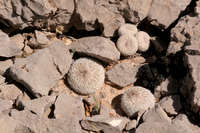Plants miniature, erect, usually unbranched [branched], not deep-seated in substrate. Roots diffuse [tuberlike in E. pachyrhiza of Mexico]. Stems unsegmented, mostly spheric, often flat-topped, 1-4(-6) × 2-4(-6) cm, surface completely obscured by spines; tubercles numerous, not confluent into ribs, hemispheric or short cylindric, very small, ca. 1-3 mm; areoles at tips of tubercles, nearly circular, elliptic when distended by flower or fruit, copiously woolly only at sexually mature stem apex; areolar glands absent; cortex and pith not mucilaginous. Spines 20-90 per areole, in 1-5 series, appressed on sides of stems, erect at sexually mature stem apex, white to ashy gray, straight, terete, slender, innocuous, 4.5-12 mm at sexually mature stem apex, often shorter from breakage or wear, smooth or microscopically roughened by breakup of epidermis, not distinguishable as radial and central spines. Flowers diurnal, borne at adaxial margins of spine clusters deep within woolly stem apex, inconspicuous, only distal portion visible from spines and hairs, funnelform, 0.6-1.7 × 0.3-1.7 cm; outer tepals entire or sparsely erose-fimbriate; inner tepals pink to white (rarely yellow), (1-)2-6(-9) × 1-2.3(-3) mm, margins entire or perhaps weakly erose-denticulate; ovary smooth, scales, hairs, and spines absent; stigma lobes (2-)3-4(-6), white, to 1 mm. Fruits indehiscent, bright red, narrowly cylindric, 3-20 × 2-3(-5) mm, weakly succulent, soon drying and papery, smooth, spineless; pulp absent; floral remnant deciduous. Seeds blackish, obliquely hemispheric, 1.2-1.4 × 1 mm, glossy, impressed-reticulate; testa cells flat or slightly convex, anticlinal cell walls not protruding. x = 11.
In fully adult plants of Epithelantha, the distal portions of the longest spines are worn, leaving all but the apex of the plant covered with short, innocuous spines. Where the ranges of the two species in the flora area overlap, they usually occur on different geologic substrates, although they grow intermingled with no evidence of hybridization, at some sites in Coahuila, Mexico. The interspecific differences have been obscured by published illustrations of misidentified specimens and by inaccurate spine counts.
Although generally resembling Mammillaria and superficially similar to M. lasiacantha, chloroplast DNA evidence somewhat inconclusively indicates that Epithelantha is taxonomically isolated and more closely related to Pediocactus and Ariocarpus than to Mammillaria (C. A. Butterworth et al. 2002).




